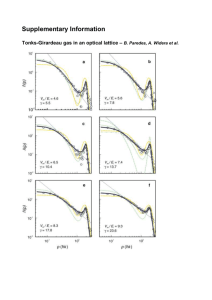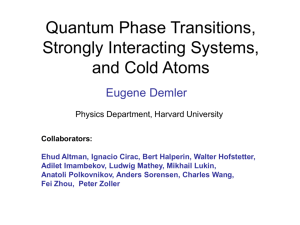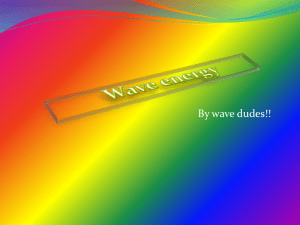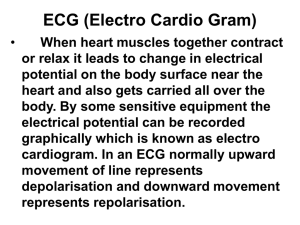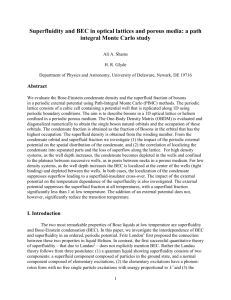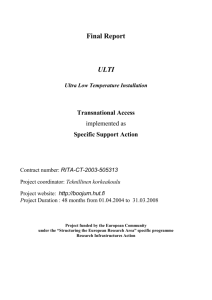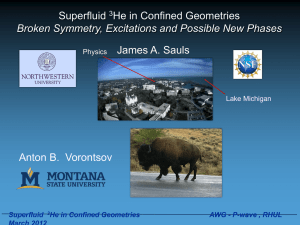sankalpa_ghosh
advertisement
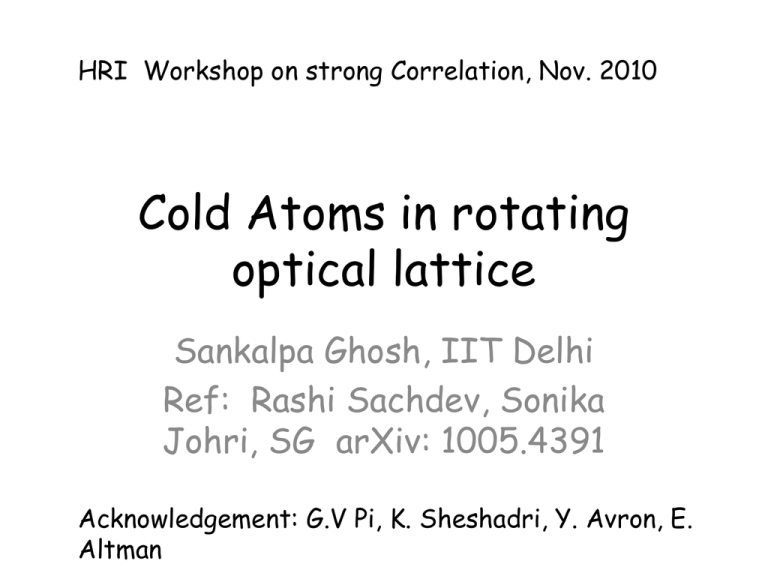
HRI Workshop on strong Correlation, Nov. 2010 Cold Atoms in rotating optical lattice Sankalpa Ghosh, IIT Delhi Ref: Rashi Sachdev, Sonika Johri, SG arXiv: 1005.4391 Acknowledgement: G.V Pi, K. Sheshadri, Y. Avron, E. Altman Bosons and Fermions Nobel Prizes 1997, 2001 Bose Einstein Condensate of Cold Atoms Bose Einstein condensate of cold atoms T=nK Characterized by a macroscopic wave function N 0 Described by Gross-Pitaevski equation 2 2 2m g * V ext g 4 a 2m Gross Pitaevskii description works if L 2 , V ext V trap 2 2 mg Optical Lattices • Optical lattices are formed by standing waves of counter propagating laser beams and act as a lattice for ultra cold atoms. V ( x , y , z ) V 0 [sin • 2 ( kx ) sin ( ky ) sin ( kz )] 2 2 These systems are highly tunable: lattice spacing and depth can be varied by tuning the frequency and intensity of lasers. Nature, Vol 388, 1997 • These optical lattices thus are artificial perfect crystals for atoms and act as an ideal system for studying solid state physics phenomenon, with more tunability of parameters than in actual solids. Bose Hubbard Model If the wavelength of the lattice potential is of the order of the coherence length then the Gross-Pitaevskii description breaks down. Tight binding approximation ˆ ( x) i ai w ( x xi ) The many boson hamiltonian is Bose Hubbard Model H t i, j (aˆ i aˆ j h .c ) U 2 nˆ ( nˆ i i 1) ( V T ) nˆ i i i Trapping potential confining frequency 10-200 Hz Optical Lattice potential confining frequency 10-40 KHz U 4 a s m t I Bloch, Nature (review article) 2 | w( x) | d x 4 w ( x xi ) [ * 3 2 2m V 0 ]w ( x xi ) d x 2 3 Bose Hubbard Model Bose Hubbard Model : It describes an interacting boson gas in a lattice potential, with only onsite interactions. H t (aˆ i, j i aˆ j h .c ) U 2 nˆ i i ( nˆ i 1) nˆ i i Fisher et al. PRB (1989) Sheshadri et al. EPL(1993) Jaksch et.al, PRL (1998) t>> U Superfluid phase : sharp interference pattern Mott Insulator phase : phase coherence lost U >> t Mean field treatment Sheshadri et al. EPL (1993) Decouple the hopping term and retain the terms only linear in fluctuation aˆ i aˆ i aˆ i aˆ i , aˆ i aˆ i aˆ i aˆ j ( aˆ i aˆ i ) H MF i U 2 i n O( ) 2 nˆ i ( nˆ i 1) ( aˆ i aˆ i ) i i 2 f i n ni 2 nˆ i Gutzwiller variational Wave function Cold Atoms with long range Interaction •Example 1 : dipolar cold gases Example 2: Cold Polar Molecules •(52Cr Condensate, T. Pfau’s group Stutgart ( PRL, 2005) U dd 2 C dd 1 3 cos , C dd 0 m2 3 4 r Example 3: BEC coupled with excited Rydberg states: ( Nath et al., PRL 2010) Add Optical lattice Tight binding approximation Extended Bose Hubbard Model Extended Bose Hubbard Model H t (aˆ i aˆ j h .c ) i, j V2 nˆ nˆ i k V3 i ,k nˆ nˆ i l U 2 nˆ ( nˆ i i i i nˆ nˆ i j i, j NN i ,l NNN 1) nˆ i V1 NNNN K Goral et al. PRL,2002 Santos et al. PRL, 2003 Minimal EBH model-just add the nearest neighbor interaction H t i, j (aˆ i aˆ j h .c ) U 2 nˆ i i ( nˆ i 1) nˆ i V i nˆ nˆ i j i, j T D Kuhner et al. (2000) New Quantum Phases – Density wave and supersolid Due to the competition between NN term and the onsite interaction, new phases such as Density wave and supersolids are formed DW Kovrizhin , G. V. Pai, Sinha, EPL 72(2005) G. G. Bartouni et al. PRL (2006) Pai and Pandit (PRB, 2005) (½)=|1,0,1,0,1,0,......> MI( 1) =|1,1,1,1,……> At t=0, we have transitions between DW (n/2) to MI(n) at U ( n 1) 2Vdn and then to DW(n/2+1) at Un 2Vdn d - being the dimension of system. Phase diagram of e-BHM with DW , SS, MI and SF phases Density Wave Phase : • Alternating number of particles at each site of the form | n , n , n , n .... 1 2 1 2 Superfluid order parameter or the macroscopic wave function vanishes. There is no coherence between the atomic wave functions at sites, on the other hand site states are perfect Fock states Crystalline Supersolid Phase : ( Superfluid +Density wave ) Superfluid Kim and Chan, Science (2004) • Why Superfluid? , there is macroscopic wave| | 0 function showing superfluid behaviour, flows effortlessly. • Why Crystalline ? Order parameter shows an oscillatory behaviour as a function of site coordinate Soldiers marching along coherently Magnetic field for neutral atoms How to create artificial magnetic field for neutral atoms? Hˆ 0 2 pˆ 2m 1 2 mr 2 2 2 1 1 2 2 2 ˆ ˆ ˆ H rot H 0 L z ( pˆ m ( r )) m ( ) r 2m 2 m B 2 zˆ , A ( r ) JILA, Oxford G. Juzelineus et al. PRA (2006) Rotating Optical Lattice Y J Lin et al. Nature(2009) Bose Hubbard model in a magnetic field Hˆ 1 d r ˆ 4 a 2 m ˆ ( x) 2 2 ( r )( ( i A ) V o )ˆ ( r ) 2m d r (ˆ 2 ( r )) ( ( r )) 2 ai w ( x xi )e i x dr A ( r ) xi i H t i, j (aˆ i aˆ j exp( i ij ) h .c ) U 2 nˆ i i ( nˆ i 1) nˆ i V i nˆ nˆ i j i, j M. Niemeyer et al(1999), J Reijinders et al. (2004), C. Wu et al. (2004) M Oktel et al. (2007), D. GoldBaum et al. (2008) (2008), Sengupta and Sinha (2010), Das Sharma et al. (2010) Topological constraint Extended Bose Hubbard Model under ( R.Sachdeva, S.Johri, S.Ghosh arXiv 1005.4391v1 ) magnetic field H t (aˆ i aˆ j exp( i ij ) h .c ) U i, j 2 nˆ i ( nˆ i 1) nˆ i V i i nˆ nˆ i i, j • Ground state of the Hamiltonian is found by variational minimization with a Gutzwiller wave function | i | H | fn | n i i n • For the Density wave phase we have two sublattices A & B | (| A A B ) N /2 N /2 | )(| i A 1 n f iA n * Set m=n f iA n | n iA n ,n | B i B 1 f mB | m i B i m f mB m , n i 0 0 1 Mott Phase j Goldbaum et al ( PRA, 2008) Umucalilar et al. (PRA, 2007) Reduced Basis ansatz H t (aˆ i aˆ j exp( i ij ) h .c ) i, j U 2 nˆ i ( nˆ i 1) nˆ i V i i nˆ nˆ i j i, j Close to the Mott or Density wave boundary only two neighboring Fock states are occupied MI-SF DW-SS | f n 1 | n 1 f n | n f n 1 | n 1 | iA f n A1 | n 1 f n A | n f n A1 | n 1 , n n 0 | iB f mB1 | m 1 f mB | m f mB 1 | m 1 , m n 0 1 i i i i i i ( f n A1 , f n A , f n A1 ) ( 1 A , i i i ( f mB1 , f mB , f mB1 ) ( 1 B , i i i 1 1A 2 A , 2 A ) 2 2 1 1B 2 B , 2 B ) 2 2 Variational minimization of the energy gives A p n 4Vm , h [( n 1) 4Vm ] B p m 4Vn , h [( m 1) 4Vn ] A ~ pA, h, B B A,B p ,h Time dependent variational mean field theory DW Boundary ( k ) 2 t (cos k x cos k y ) Include Rotation Substitute the variational parameters (f iA n 1 , f iA n , f iA n 1) [ iA 1 iA A , 1 | AA | (| 1A | | 2A | ), 2A AA ] i i i 2 i 2 i 2 i ( f mB1 , f mB , f mB 1 ) [ 1 B BB , 1 | BB | (| 1 B | | 2 B | ), 2 B BB ] i i i i i 2 i 2 i 2 i i Two component superfluid order parameter ~ t 1 t 1 2 ~ i ,i , A ,AB B A aˆ iA iA 1 ( 2 ) A , B i A ,i B i * n ( n 4Vm ) n 1 [1 n n 4Vm 1 4Vm B aˆ iB iB ] m 1 f mB f mB 1 i * A A , iA Minimize with respect to the variational parameters ~ |t | ~ |t | iB 1 ~i *~i ( A A B B exp( i i A , i B ) c .c ) i, j i * m 2 1 (m n, n m ) iA 1 i * n 1 f n A f n A1 [ A B i A ,i B ~ i A ~ iB ]( nˆ . )[ A B T ] iB B ~ iA 2 ~ iB 2 | | | A B | EG i ~ i A * ~ iB * iB B iA j ~ iA ~ iB | A | | B | E G iA 2 2 iB nˆ cos i A , i B xˆ sin i A , i B yˆ , x xˆ y yˆ Harper Equation ~B i ( x 1, y ) e i y B 1 ~A ~B ~B ~B i y i x i x i B ( x 1, y ) e i B ( x , y 1) e i B ( x 1, y ) e ~ iA ( x, y ) t 1 ~B ~A ~A ~A ~A i y i y i x i x i ( x 2, y )e i ( x, y )e i ( x 1, y 1) e i ( x 1, y 1) e ~ i ( x 1, y ) t A A A A B Spinorial Harper Equation ~A~B T 1 ~A~B T ˆ ( n . )[ ] iA iB ~ [ i A i B ] t i A ,i B ~ ( x , y ) [exp( i i A ,i B 2 ) exp( i i A ,i B )] T 2 Where the spatial part of the wave function satisfies ~ ( x 1, y ) e i y 1 ~ ~ ~ ~ i y i x i x ( x 1, y ) e ( x , y 1) e ( x 1, y ) e ~ ( x, y ) t Eigenvalues of Hofstadter butterfly can be mapped to 1 ~ t Hofstadter Butterfly Hofstadter Equation in Landau gauge ( x a, y) (x a, y) e ieBay ( x a , y )e 2 hc ( x a , y )e Color HF Avron et al. ieBax hc ieBax ( x, y a ) e ieBay 2 hc e hc ( x , y a ) ( x , y ) ieBax 2 hc ieBax ( x, y a ) e 2 hc ( x , y a ) ( x , y ) Typically electron in a uniform magnetic field forms Landau Level each of is highly degenerate E (n 1 2 Nd 0 ) c , B.A, 0 hc e A plot of such energy levels as a function of Increasing strength of magnetic field will be a set Of straight line all starting from origin If a periodic potential is added as an weak perturbation then it lifts this degeneracy and splits each Landau level into nΦ sublevels where nΦ=Ba2/φ0 namely the number of fluxes through each unit cell Hofstadter butterfly DW Phase Boundary ~ t 1 t 1 2 ~ i ,i , A ,AB B ( n 4Vm ) n 1 1 ( 2 ) A , B i A ,i B [1 n n 4Vm 1 4Vm ] 2 1 (m n, n m ) Boundary of the DW & MI phase related to edge eigen value of Hofstadter Butterfly Modification of the phase boundary due to the rotation or artificial magnetic field Plot of Eigenfunction Highest band of the Hofstadter butterfly Vortex in a supersolid Vortex in a superfluid Checker board vortices Surrounding superfluid density Shows two sublattice modulation What about the other eigenvalues? Good starting points for more general solutions within Gutzwiller approximation Density wave order parameter i ( 1) [ nˆ i 1 N ( nˆ i ) i Experimental detection Real Space technique ? Time of flight imaging : interference pattern will bear signature of the sublattice modulated superfluid density around the core Momentum space Bragg Scattering : Structure factor, Phase sensitivity etc.
